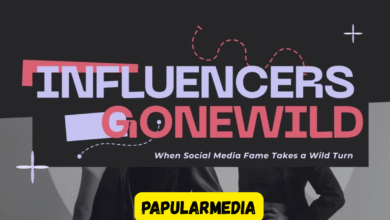InfluencersGoneWild: A Deep Dive into the Digital Phenomenon

The Rise of Influencer Culture
InfluencersGoneWild In the last decade, the internet has undergone a transformative evolution. Among the most prominent developments is the rise of social media influencers—individuals who build large followings by creating content across platforms like Instagram, TikTok, YouTube, and X (formerly Twitter). These influencers captivate audiences with their personalities, lifestyles, and authenticity. As their influence expands, so too does their power to shape trends, market products, and even influence political opinions. This has birthed a new digital culture where personalities, not corporations, hold sway.
With fame comes scrutiny, and the rise of influencer culture has brought with it a wave of controversies and scandals. The term “InfluencersGoneWild” has emerged to describe those moments when influencers break societal norms, behave recklessly, or get caught in situations that tarnish their reputations. It’s a term loaded with curiosity, critique, and commentary on the unchecked power and pitfalls of internet fame.
What Does “InfluencersGoneWild” Really Mean?
The phrase “InfluencersGoneWild” typically refers to instances where influencers act in ways that shock, offend, or scandalize their audiences. This could range from tone-deaf content and public meltdowns to financial fraud and inappropriate behavior. While some cases are minor lapses in judgment, others expose deeper issues within influencer culture, including entitlement, lack of accountability, and the relentless pressure to stay relevant.
Unlike traditional celebrities, influencers often start as ordinary individuals who gain attention through charisma and relatability. However, as their following grows, the line between their personal and public lives blurs. The result is a volatile environment where one misstep can lead to massive backlash. “Gone wild” moments thus become viral, dissected across social media and online forums, fueling debates about morality, ethics, and fame.
The Impact of Virality and Public Shaming
One of the key reasons the “InfluencersGoneWild” narrative garners so much attention is the nature of virality. On social media, content spreads rapidly. A single video, tweet, or post can reach millions within hours. When influencers behave badly, the internet acts as both jury and executioner. Public shaming becomes entertainment, and platforms reward outrage with engagement.
This rapid escalation of events can be devastating for the individuals involved. Sponsorships get dropped, follower counts plummet, and reputations are damaged beyond repair. Some influencers try to make comebacks by issuing apologies or rebranding themselves, while others vanish from the digital landscape entirely. The culture of “canceling” individuals for their behavior has become an integral part of influencer dynamics.
Fame Without Boundaries
Traditional celebrities typically have managers, PR teams, and legal advisors to keep their public personas polished. Many influencers, however, start solo and operate without such guidance. This lack of a support system often leads to impulsive decisions. When fame arrives quickly and unexpectedly, it becomes difficult to navigate. The same platform that propelled them to stardom becomes the stage for their downfall.
In many “InfluencersGoneWild” cases, individuals fail to recognize the influence they wield. Posting content without fully understanding its implications or cultural context often results in backlash. Whether it’s engaging in dangerous challenges, mocking marginalized groups, or flaunting excessive wealth during economic crises, these actions reflect a disconnect from reality. The pursuit of clout and engagement blinds influencers to the real-world consequences of their actions.
The Role of Algorithms and Engagement Culture
The platforms themselves play a role in fueling this behavior. Social media algorithms prioritize content that generates engagement—especially if it’s controversial or shocking. Influencers who “go wild” often receive a temporary surge in attention, which can incentivize others to engage in similar behavior.
Outrage becomes a currency. The more people talk about a scandal, the more visibility it gets. This creates a paradox where bad behavior can actually be rewarded in the short term. Some influencers may even manufacture controversy to stay relevant, relying on the “any publicity is good publicity” mindset. Over time, this shapes the culture of the internet, normalizing extreme behavior in pursuit of fame.
The Psychology Behind Influencer Misconduct
Understanding why influencers behave in self-destructive ways requires examining the psychological toll of internet fame. Constant exposure, pressure to perform, and the desire to maintain relevance can lead to burnout, anxiety, and poor decision-making. Influencers live in a world where their every move is scrutinized, and they often lack privacy or emotional boundaries.
Many start young and are not emotionally equipped to handle the complexities of digital fame. The validation from likes, shares, and comments becomes addictive, reinforcing risky or controversial behavior. Without proper mental health support, influencers can spiral into destructive cycles, culminating in the kinds of scandals that populate the “InfluencersGoneWild” narrative.
Society’s Fascination with Scandal
There is a reason why stories of influencers going off the rails attract such large audiences. Human beings are naturally drawn to drama, and the internet amplifies this curiosity. Seeing someone who was once admired fall from grace provides a complex mix of emotions—disappointment, schadenfreude, and even relief.
Audiences project ideals onto influencers, and when those ideals are shattered, it creates a compelling story. Scandals also serve as cautionary tales, reminding people of the dangers of unchecked fame. In a way, the downfall of influencers becomes a modern morality play, teaching lessons about humility, accountability, and the limits of personal branding.
Redemption and the Possibility of Comeback
While some influencers disappear after scandals, others manage to rebuild their reputations. Redemption arcs are possible, especially if the individual takes responsibility, makes genuine amends, and commits to change. The public is often willing to forgive when they sense sincerity.
However, the path to redemption is fraught with challenges. A single misstep during a comeback attempt can reignite the backlash. Influencers must navigate a delicate balance between owning their past and creating a future that aligns with the values of their audience. In this way, the digital world offers both punishment and second chances—though not always fairly or predictably.
Legal and Ethical Ramifications
“InfluencersGoneWild” moments are not just about public perception—they can have serious legal consequences. False advertising, misuse of sponsored content, defamation, and exploitation are just a few of the legal issues influencers may face. Governments around the world are beginning to implement stricter regulations for digital creators, demanding more transparency and accountability.
At the same time, ethical questions continue to arise. What responsibilities do influencers have toward their young audiences? Should they be held to higher standards due to their influence? These are questions that platforms, creators, and society at large must grapple with as the line between entertainment and responsibility blurs further.
The Future of Influencer Culture
As influencer culture matures, the industry will likely continue to evolve. Influencers will be required to professionalize their operations, hiring teams to manage their public image and ensuring compliance with regulations. Audiences, too, will become more discerning, demanding authenticity and accountability.
The phenomenon of “InfluencersGoneWild” may not disappear, but its nature will change. Scandals will still occur, but they may be met with more measured responses. Education about digital literacy, mental health, and ethical content creation will play a vital role in shaping a healthier online ecosystem.
Ultimately, the influencer world is a mirror of society’s values. If it currently reflects chaos and controversy, it is because those elements captivate our collective attention. Change will come not only from within the industry but from audiences choosing to reward substance over spectacle.
FAQs about InfluencersGoneWild
What is the meaning of “InfluencersGoneWild”?
It refers to incidents where social media influencers act recklessly or get involved in controversies that attract widespread public backlash. These behaviors often include offensive content, unethical actions, or public meltdowns.
Why do influencers behave this way?
There are several reasons, including the pressures of constant visibility, desire for engagement, lack of professional guidance, and the addictive nature of internet fame. Many are also young and unprepared for the responsibilities that come with their influence.
Does controversy help influencers gain more followers?
Sometimes, yes. Controversy often leads to a surge in engagement, which algorithms can promote. However, this boost is usually temporary and can lead to long-term damage to credibility and partnerships.
Can influencers recover from scandals?
Yes, some influencers manage to make comebacks by taking responsibility, making amends, and rebuilding trust. Others may struggle or leave the public eye entirely. Recovery depends on the severity of the incident and the sincerity of the individual’s response.
Is influencer culture dangerous?
It can be, especially when individuals wield significant influence without accountability. Misleading content, unhealthy lifestyle promotion, and emotional manipulation are just a few risks. However, with education and regulation, the culture can be made safer and more positive.
Are platforms responsible for influencer behavior?
To an extent, yes. Social media platforms contribute to shaping user behavior through their algorithms and lack of moderation in some cases. They are beginning to introduce policies, but much responsibility also lies with the influencers themselves and their audiences.
Why is the public so fascinated with influencer scandals?
Scandals are entertaining, dramatic, and humanizing. People enjoy seeing those in power face consequences, and scandals often expose the contrast between online personas and real behavior. They also serve as a way for society to critique fame and modern values.
How can influencers avoid going “wild”?
By building support systems, setting boundaries, seeking professional guidance, and staying grounded in their values. Mental health support, media training, and ethical content creation are essential tools for avoiding scandal.
What lessons can audiences learn from “InfluencersGoneWild” stories?
They highlight the importance of critical thinking, not InfluencersGoneWild idolizing public figures, and understanding that what’s online isn’t always reality. These stories also encourage audiences to value authenticity over perfection.
Will influencer culture continue to grow?
Yes, the industry is expected to grow, but it will likely become more structured, regulated, and professional. With evolving expectations and standards, influencers will need to adapt to maintain their relevance and reputation.




